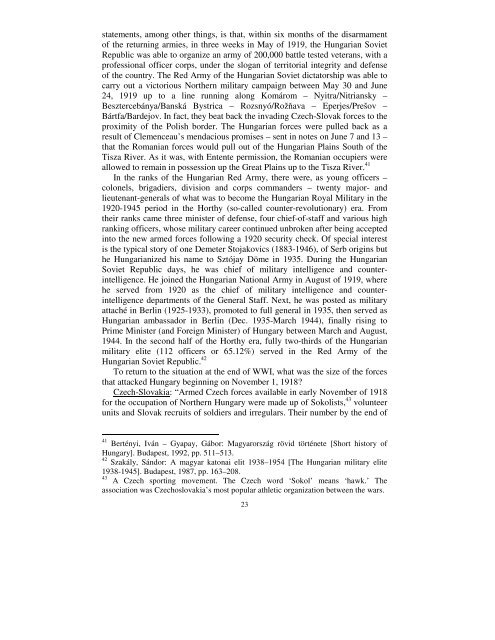The Fate of Western Hungary 1918-1921 - Corvinus Library ...
The Fate of Western Hungary 1918-1921 - Corvinus Library ...
The Fate of Western Hungary 1918-1921 - Corvinus Library ...
You also want an ePaper? Increase the reach of your titles
YUMPU automatically turns print PDFs into web optimized ePapers that Google loves.
statements, among other things, is that, within six months <strong>of</strong> the disarmament<br />
<strong>of</strong> the returning armies, in three weeks in May <strong>of</strong> 1919, the Hungarian Soviet<br />
Republic was able to organize an army <strong>of</strong> 200,000 battle tested veterans, with a<br />
pr<strong>of</strong>essional <strong>of</strong>ficer corps, under the slogan <strong>of</strong> territorial integrity and defense<br />
<strong>of</strong> the country. <strong>The</strong> Red Army <strong>of</strong> the Hungarian Soviet dictatorship was able to<br />
carry out a victorious Northern military campaign between May 30 and June<br />
24, 1919 up to a line running along Komárom – Nyitra/Nitriansky –<br />
Besztercebánya/Banská Bystrica – Rozsnyó/Rožňava – Eperjes/Prešov –<br />
Bártfa/Bardejov. In fact, they beat back the invading Czech-Slovak forces to the<br />
proximity <strong>of</strong> the Polish border. <strong>The</strong> Hungarian forces were pulled back as a<br />
result <strong>of</strong> Clemenceau’s mendacious promises – sent in notes on June 7 and 13 –<br />
that the Romanian forces would pull out <strong>of</strong> the Hungarian Plains South <strong>of</strong> the<br />
Tisza River. As it was, with Entente permission, the Romanian occupiers were<br />
allowed to remain in possession up the Great Plains up to the Tisza River. 41<br />
In the ranks <strong>of</strong> the Hungarian Red Army, there were, as young <strong>of</strong>ficers –<br />
colonels, brigadiers, division and corps commanders – twenty major- and<br />
lieutenant-generals <strong>of</strong> what was to become the Hungarian Royal Military in the<br />
1920-1945 period in the Horthy (so-called counter-revolutionary) era. From<br />
their ranks came three minister <strong>of</strong> defense, four chief-<strong>of</strong>-staff and various high<br />
ranking <strong>of</strong>ficers, whose military career continued unbroken after being accepted<br />
into the new armed forces following a 1920 security check. Of special interest<br />
is the typical story <strong>of</strong> one Demeter Stojakovics (1883-1946), <strong>of</strong> Serb origins but<br />
he Hungarianized his name to Sztójay Döme in 1935. During the Hungarian<br />
Soviet Republic days, he was chief <strong>of</strong> military intelligence and counterintelligence.<br />
He joined the Hungarian National Army in August <strong>of</strong> 1919, where<br />
he served from 1920 as the chief <strong>of</strong> military intelligence and counterintelligence<br />
departments <strong>of</strong> the General Staff. Next, he was posted as military<br />
attaché in Berlin (1925-1933), promoted to full general in 1935, then served as<br />
Hungarian ambassador in Berlin (Dec. 1935-March 1944), finally rising to<br />
Prime Minister (and Foreign Minister) <strong>of</strong> <strong>Hungary</strong> between March and August,<br />
1944. In the second half <strong>of</strong> the Horthy era, fully two-thirds <strong>of</strong> the Hungarian<br />
military elite (112 <strong>of</strong>ficers or 65.12%) served in the Red Army <strong>of</strong> the<br />
Hungarian Soviet Republic. 42<br />
To return to the situation at the end <strong>of</strong> WWI, what was the size <strong>of</strong> the forces<br />
that attacked <strong>Hungary</strong> beginning on November 1, <strong>1918</strong>?<br />
Czech-Slovakia: “Armed Czech forces available in early November <strong>of</strong> <strong>1918</strong><br />
for the occupation <strong>of</strong> Northern <strong>Hungary</strong> were made up <strong>of</strong> Sokolists, 43 volunteer<br />
units and Slovak recruits <strong>of</strong> soldiers and irregulars. <strong>The</strong>ir number by the end <strong>of</strong><br />
41 Bertényi, Iván – Gyapay, Gábor: Magyarország rövid története [Short history <strong>of</strong><br />
<strong>Hungary</strong>]. Budapest, 1992, pp. 511–513.<br />
42 Szakály, Sándor: A magyar katonai elit 1938–1954 [<strong>The</strong> Hungarian military elite<br />
1938-1945]. Budapest, 1987, pp. 163–208.<br />
43 A Czech sporting movement. <strong>The</strong> Czech word ‘Sokol’ means ‘hawk.’ <strong>The</strong><br />
association was Czechoslovakia’s most popular athletic organization between the wars.<br />
23
















